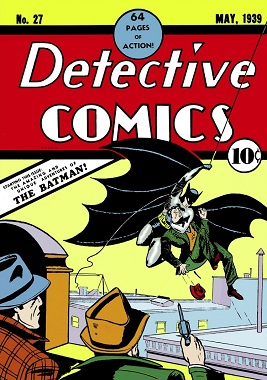Batman
Batman is a fictional superhero appearing in American comic books published by DC Comics. The character was created by artist Bob Kane and writer Bill Finger, and first appeared in Detective Comics #27 in 1939. Originally named "the Bat-Man," the character is also referred to by such epithets as the "Caped Crusader," the "Dark Knight," and the "World's Greatest Detective."
Creation and Development[edit | edit source]
Batman's creation was influenced by literary characters of the 1930s, such as Zorro and Sherlock Holmes, and the art deco architecture of the period. Bob Kane conceived the character as a way to capitalize on the popularity of Superman. Bill Finger contributed significant ideas such as giving the character a cowl instead of a simple domino mask, a cape instead of wings, and gloves; he also wrote the first Batman story and created the character's alter ego, Bruce Wayne.
Character Biography[edit | edit source]
Bruce Wayne, the secret identity of Batman, is a wealthy industrialist, playboy, and philanthropist. Witnessing the murder of his parents as a child leads him to train to the peak of physical and intellectual perfection and don a bat-themed costume in order to fight crime. Batman operates in the fictional Gotham City, with assistance from various supporting characters including his butler Alfred Pennyworth, and fights an assortment of villains influenced by the character's rogues gallery, including his archenemy, the Joker.
Powers and Abilities[edit | edit source]
Unlike most superheroes, Batman does not possess any superpowers; instead, he relies on his intellect, physical prowess, martial arts abilities, detective skills, science and technology, wealth, and indomitable will. A large assortment of gadgets and vehicles (notably the Batmobile) are at his disposal, all bearing the bat motif.
Cultural Impact[edit | edit source]
Batman has become a pop culture icon, with a presence in nearly every medium of entertainment and merchandise. The character has been adapted in live-action and animated television series, films, video games, and radio. The 1989 Batman film directed by Tim Burton and the 2008 The Dark Knight directed by Christopher Nolan have been particularly influential. Batman has also been a character in various graphic novels and comic book series outside of the traditional Batman titles.
In Other Media[edit | edit source]
Batman's adaptations include the 1960s Batman television series, portrayed by Adam West; and a successful series of films beginning with Batman (1989), directed by Tim Burton and starring Michael Keaton. In the 21st century, the character was revitalized through Christopher Nolan's The Dark Knight Trilogy. Animated series such as Batman: The Animated Series have also contributed significantly to the character's presence in popular culture.
Legacy[edit | edit source]
Batman's enduring popularity has led him to be recognized as one of the greatest comic book characters of all time. The character has been used in various campaigns addressing social issues and has appeared in merchandise sold around the world.
Navigation: Wellness - Encyclopedia - Health topics - Disease Index - Drugs - World Directory - Gray's Anatomy - Keto diet - Recipes
Search WikiMD
Ad.Tired of being Overweight? Try W8MD's physician weight loss program.
Semaglutide (Ozempic / Wegovy and Tirzepatide (Mounjaro) available.
Advertise on WikiMD
WikiMD is not a substitute for professional medical advice. See full disclaimer.
Credits:Most images are courtesy of Wikimedia commons, and templates Wikipedia, licensed under CC BY SA or similar.
Contributors: Prab R. Tumpati, MD




